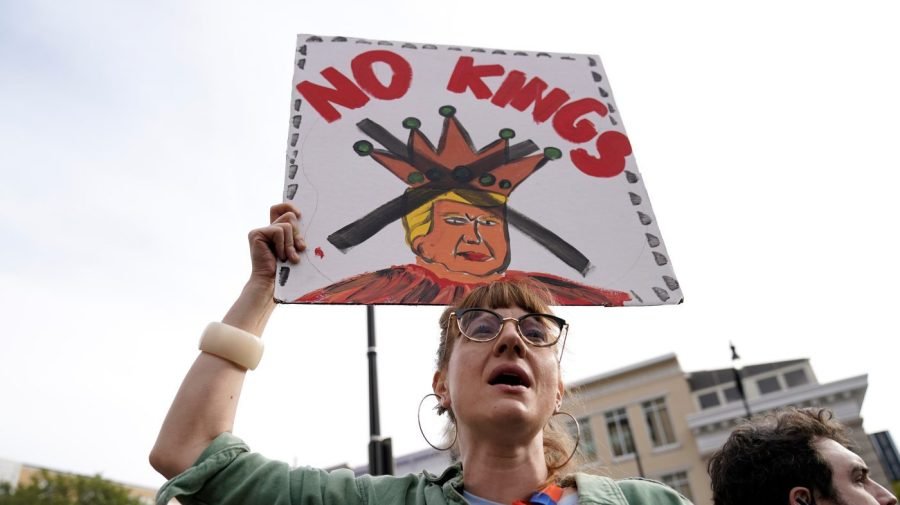
After 7 million people took to the streets to protest his presidency, President Trump assured the country that he doesn’t consider himself a king. However, he certainly lives like one, and the middle-class Americans who helped elect him are paying for it, literally or metaphorically.
The group Public Employees for Environmental Responsibility tallied several of Trump’s extravagances four months into his current term. They include nearly half a billion dollars for “vanity projects,” including his military parade, a statuary garden, upgrades on Air Force One, and gilding for the Oval Office. He spent $1.7 million on new furniture and fixtures in the White House.
The parade cost the U.S. Army $30 million, plus expenses for security and street repairs. Now Trump is planning a “spectacular birthday party” next July to celebrate the 250th anniversary of the Declaration of Independence. That will cost at least $100 million. During the event, Trump plans to unveil a National Garden of American Heroes, featuring 250 life-sized statues of as-yet-unnamed notables. The estimated cost is $34 million.
According to the Golf Tracker website, Trump has spent 25 percent of his presidency golfing so far, which has cost taxpayers $98 million. At that rate, his golf outings will cost more than the $150 million he spent on the sport during his first term.
Federal records show that during the first few months of his current term, the Secret Service spent $100,000 during 129 visits to Trump’s properties. It spent nearly $2 million at Trump properties during his first term. The president obviously needs protection; the question is whether his businesses should profit from it.
Which of Trump’s transactions is the most outrageous? What about his claim that the Department of Justice (i.e., taxpayers) owes him $230 million for alleged harms he suffered due to the investigations of him related to the Russia “collusion” scandal and his theft of classified documents? Since Trump controls the Justice Department, the claim constitutes a clear conflict of interest. It is also a stunning show of chutzpah from a man who escaped trial on those counts by winning the presidency.
But the most objectionable expenditure is Trump’s deployment of the military to cities governed by Democrats. It is an authoritarian political stunt that costs hundreds of millions of dollars per city.
A close second is the $300 million, 90,000-square-foot gilded ballroom Trump is adding to the White House, which will seat 1,000 people. Although taxpayers will not be on the hook for the construction costs, they will be left with a ballroom fit for a palace, nearly twice the size of the White House itself.
Although the White House is “the people’s house,” few ordinary Americans are likely to dine and dance in the new ballroom. And although construction has been funded by donations and not by taxpayers, hoi polloi will foot the bill for the opulent dinners, drinks and entertainments Trump will host there for dignitaries and the well-to-do.
Meanwhile, the national debt hit a record $38 trillion last week. The Government Accountability Office says the impacts include higher interest rates on mortgages and cars, lower wages, and more expensive goods and services.
Trump’s big bad budget bill will add $3.4 trillion to the debt over the coming decade, while leaving 10 million more Americans without health insurance. House Speaker Mike Johnson (R-La.) claimed the bill benefits “hardworking Americans.” But as the Center for Budget and Policy Priorities put it, it “gives huge tax breaks to wealthy individuals, businesses, and large corporations while leaving behind or raising costs for millions of working families.”
Now, the continuing resolution passed by House Republicans would raise health care premiums an average of 114 percent for millions of Americans. The administration has decimated federal programs and services, targeting “Democrat-oriented” services that typically address the underprivileged and poor.
At the same time, Trump’s tariffs are pushing up the cost of living. Analysts say the tariffs will cost U.S. businesses an additional $1.2 trillion this year, with consumers bearing most of the brunt. Companies have passed two-thirds of the tariff costs — roughly $592 billion — to consumers in higher prices.
Meanwhile, the administration fired 12 percent of the federal workforce, including about 300,000 employees in the first several months of this year and more than 4,100 since the government shutdown began. Displaced civil servants have been forced into a jobs market that has lost momentum because growing economic worries are discouraging employers from hiring.
Trump makes light of this. He posted an image of his budget director, Russ Vought, as the Grim Reaper. Vought says the current round of layoffs will be “north of 10,000.”
One financial analyst writes that Trump “must continue appealing to the finances of everyday Americans if he hopes to retain the political capital he earned in November 2024.” But that horse has left the barn. Trump says he’s not royalty, but he’s acting like Marie Antoinette, whose extravagance helped spark the French Revolution.
William S. Becker is co-editor of and a contributor to “Democracy Unchained: How to Rebuild Government for the People,” and contributor to “Democracy in a Hotter Time,” named by the journal Nature as one of 2023’s five best science books. He previously served as a senior official in the Wisconsin Department of Justice and is currently executive director of the Presidential Climate Action Project, a nonpartisan climate policy think tank unaffiliated with the White House.

